Critical Reflection Paper: Childhood Trauma, Nursing Practice
VerifiedAdded on 2023/01/05
|10
|2985
|2
Report
AI Summary
This critical reflection paper explores the impact of childhood trauma on children's mental health and the effectiveness of inter-professional practice in addressing it. The paper discusses the various types of traumatic experiences children face, including physical and mental exploitation, violence, and social abuse, and highlights the long-lasting effects these experiences can have on their well-being. It emphasizes the importance of early intervention and the role of inter-professional practice, as guided by the World Health Organization, in providing comprehensive care to traumatized children. The report outlines the role of nursing staff within this inter-professional framework, emphasizing the importance of therapeutic relationships, ethical values, and cultural sensitivity. It analyzes the strengths of inter-professional practice, such as improved communication and patient-centered care, while also acknowledging potential weaknesses like diverse values among team members. The conclusion underscores the significance of inter-professional practice in enhancing communication, teamwork, and the delivery of effective healthcare and recovery for children affected by trauma.
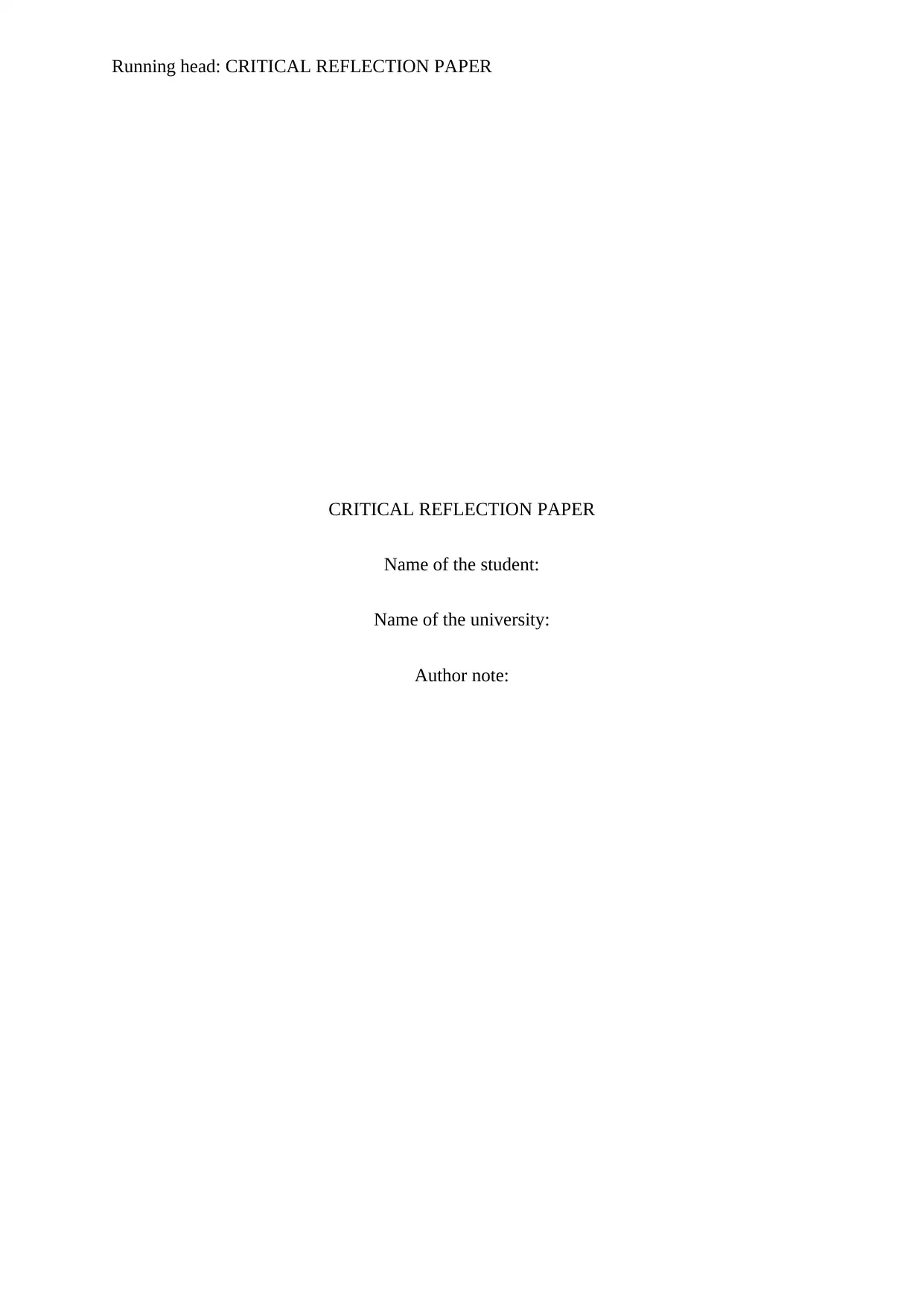
Running head: CRITICAL REFLECTION PAPER
CRITICAL REFLECTION PAPER
Name of the student:
Name of the university:
Author note:
CRITICAL REFLECTION PAPER
Name of the student:
Name of the university:
Author note:
Paraphrase This Document
Need a fresh take? Get an instant paraphrase of this document with our AI Paraphraser
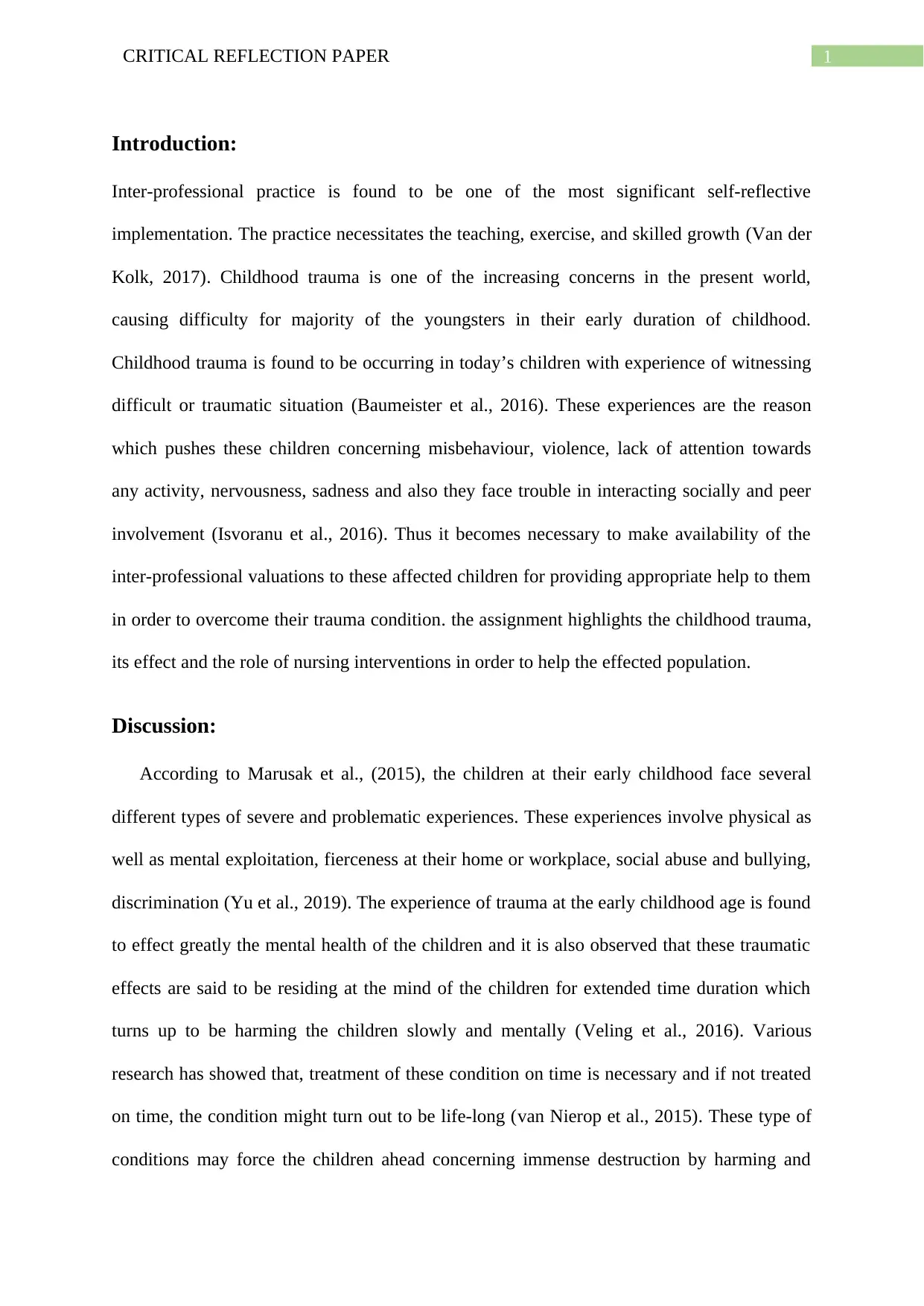
1CRITICAL REFLECTION PAPER
Introduction:
Inter-professional practice is found to be one of the most significant self-reflective
implementation. The practice necessitates the teaching, exercise, and skilled growth (Van der
Kolk, 2017). Childhood trauma is one of the increasing concerns in the present world,
causing difficulty for majority of the youngsters in their early duration of childhood.
Childhood trauma is found to be occurring in today’s children with experience of witnessing
difficult or traumatic situation (Baumeister et al., 2016). These experiences are the reason
which pushes these children concerning misbehaviour, violence, lack of attention towards
any activity, nervousness, sadness and also they face trouble in interacting socially and peer
involvement (Isvoranu et al., 2016). Thus it becomes necessary to make availability of the
inter-professional valuations to these affected children for providing appropriate help to them
in order to overcome their trauma condition. the assignment highlights the childhood trauma,
its effect and the role of nursing interventions in order to help the effected population.
Discussion:
According to Marusak et al., (2015), the children at their early childhood face several
different types of severe and problematic experiences. These experiences involve physical as
well as mental exploitation, fierceness at their home or workplace, social abuse and bullying,
discrimination (Yu et al., 2019). The experience of trauma at the early childhood age is found
to effect greatly the mental health of the children and it is also observed that these traumatic
effects are said to be residing at the mind of the children for extended time duration which
turns up to be harming the children slowly and mentally (Veling et al., 2016). Various
research has showed that, treatment of these condition on time is necessary and if not treated
on time, the condition might turn out to be life-long (van Nierop et al., 2015). These type of
conditions may force the children ahead concerning immense destruction by harming and
Introduction:
Inter-professional practice is found to be one of the most significant self-reflective
implementation. The practice necessitates the teaching, exercise, and skilled growth (Van der
Kolk, 2017). Childhood trauma is one of the increasing concerns in the present world,
causing difficulty for majority of the youngsters in their early duration of childhood.
Childhood trauma is found to be occurring in today’s children with experience of witnessing
difficult or traumatic situation (Baumeister et al., 2016). These experiences are the reason
which pushes these children concerning misbehaviour, violence, lack of attention towards
any activity, nervousness, sadness and also they face trouble in interacting socially and peer
involvement (Isvoranu et al., 2016). Thus it becomes necessary to make availability of the
inter-professional valuations to these affected children for providing appropriate help to them
in order to overcome their trauma condition. the assignment highlights the childhood trauma,
its effect and the role of nursing interventions in order to help the effected population.
Discussion:
According to Marusak et al., (2015), the children at their early childhood face several
different types of severe and problematic experiences. These experiences involve physical as
well as mental exploitation, fierceness at their home or workplace, social abuse and bullying,
discrimination (Yu et al., 2019). The experience of trauma at the early childhood age is found
to effect greatly the mental health of the children and it is also observed that these traumatic
effects are said to be residing at the mind of the children for extended time duration which
turns up to be harming the children slowly and mentally (Veling et al., 2016). Various
research has showed that, treatment of these condition on time is necessary and if not treated
on time, the condition might turn out to be life-long (van Nierop et al., 2015). These type of
conditions may force the children ahead concerning immense destruction by harming and
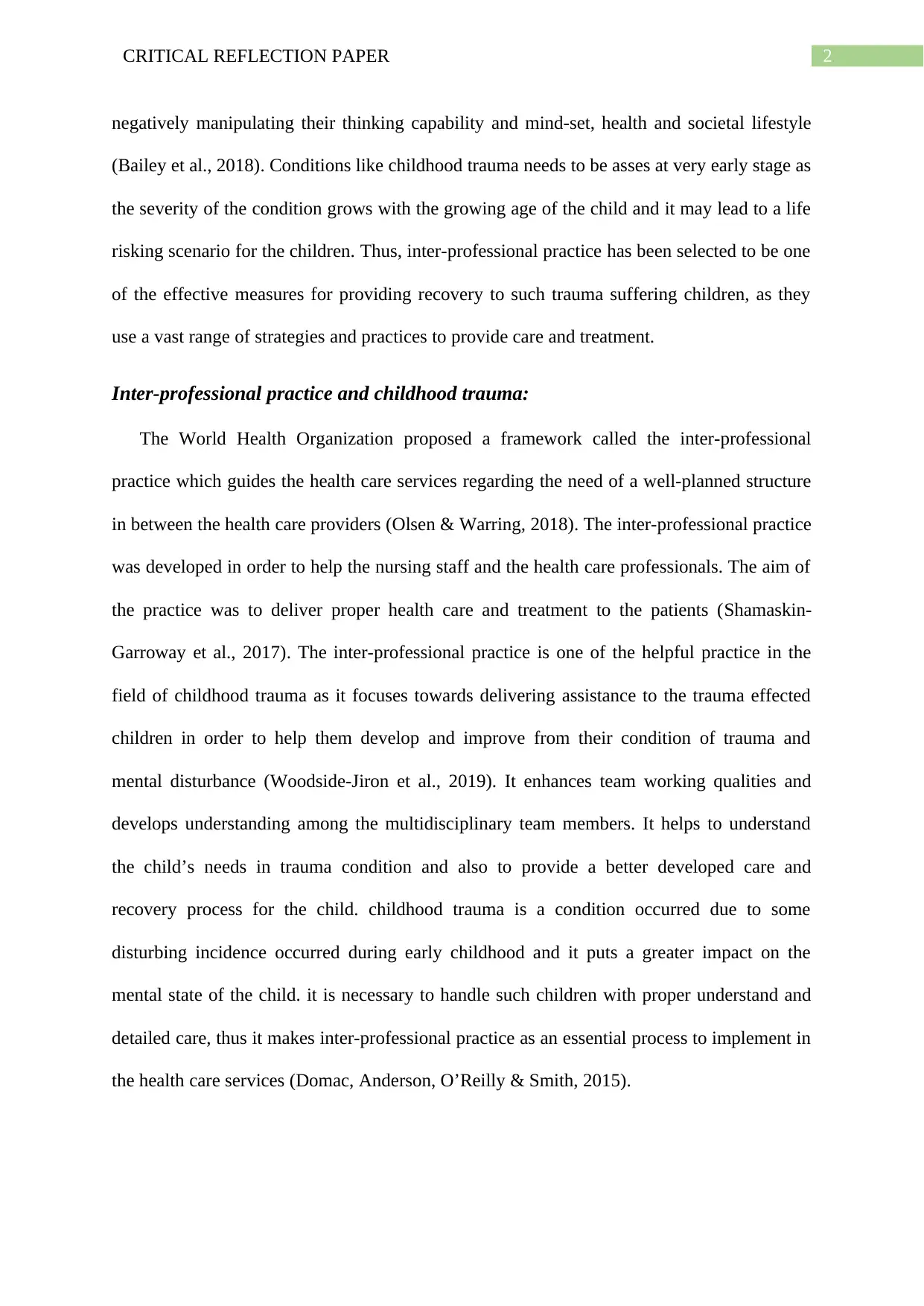
2CRITICAL REFLECTION PAPER
negatively manipulating their thinking capability and mind-set, health and societal lifestyle
(Bailey et al., 2018). Conditions like childhood trauma needs to be asses at very early stage as
the severity of the condition grows with the growing age of the child and it may lead to a life
risking scenario for the children. Thus, inter-professional practice has been selected to be one
of the effective measures for providing recovery to such trauma suffering children, as they
use a vast range of strategies and practices to provide care and treatment.
Inter-professional practice and childhood trauma:
The World Health Organization proposed a framework called the inter-professional
practice which guides the health care services regarding the need of a well-planned structure
in between the health care providers (Olsen & Warring, 2018). The inter-professional practice
was developed in order to help the nursing staff and the health care professionals. The aim of
the practice was to deliver proper health care and treatment to the patients (Shamaskin-
Garroway et al., 2017). The inter-professional practice is one of the helpful practice in the
field of childhood trauma as it focuses towards delivering assistance to the trauma effected
children in order to help them develop and improve from their condition of trauma and
mental disturbance (Woodside-Jiron et al., 2019). It enhances team working qualities and
develops understanding among the multidisciplinary team members. It helps to understand
the child’s needs in trauma condition and also to provide a better developed care and
recovery process for the child. childhood trauma is a condition occurred due to some
disturbing incidence occurred during early childhood and it puts a greater impact on the
mental state of the child. it is necessary to handle such children with proper understand and
detailed care, thus it makes inter-professional practice as an essential process to implement in
the health care services (Domac, Anderson, O’Reilly & Smith, 2015).
negatively manipulating their thinking capability and mind-set, health and societal lifestyle
(Bailey et al., 2018). Conditions like childhood trauma needs to be asses at very early stage as
the severity of the condition grows with the growing age of the child and it may lead to a life
risking scenario for the children. Thus, inter-professional practice has been selected to be one
of the effective measures for providing recovery to such trauma suffering children, as they
use a vast range of strategies and practices to provide care and treatment.
Inter-professional practice and childhood trauma:
The World Health Organization proposed a framework called the inter-professional
practice which guides the health care services regarding the need of a well-planned structure
in between the health care providers (Olsen & Warring, 2018). The inter-professional practice
was developed in order to help the nursing staff and the health care professionals. The aim of
the practice was to deliver proper health care and treatment to the patients (Shamaskin-
Garroway et al., 2017). The inter-professional practice is one of the helpful practice in the
field of childhood trauma as it focuses towards delivering assistance to the trauma effected
children in order to help them develop and improve from their condition of trauma and
mental disturbance (Woodside-Jiron et al., 2019). It enhances team working qualities and
develops understanding among the multidisciplinary team members. It helps to understand
the child’s needs in trauma condition and also to provide a better developed care and
recovery process for the child. childhood trauma is a condition occurred due to some
disturbing incidence occurred during early childhood and it puts a greater impact on the
mental state of the child. it is necessary to handle such children with proper understand and
detailed care, thus it makes inter-professional practice as an essential process to implement in
the health care services (Domac, Anderson, O’Reilly & Smith, 2015).
⊘ This is a preview!⊘
Do you want full access?
Subscribe today to unlock all pages.

Trusted by 1+ million students worldwide
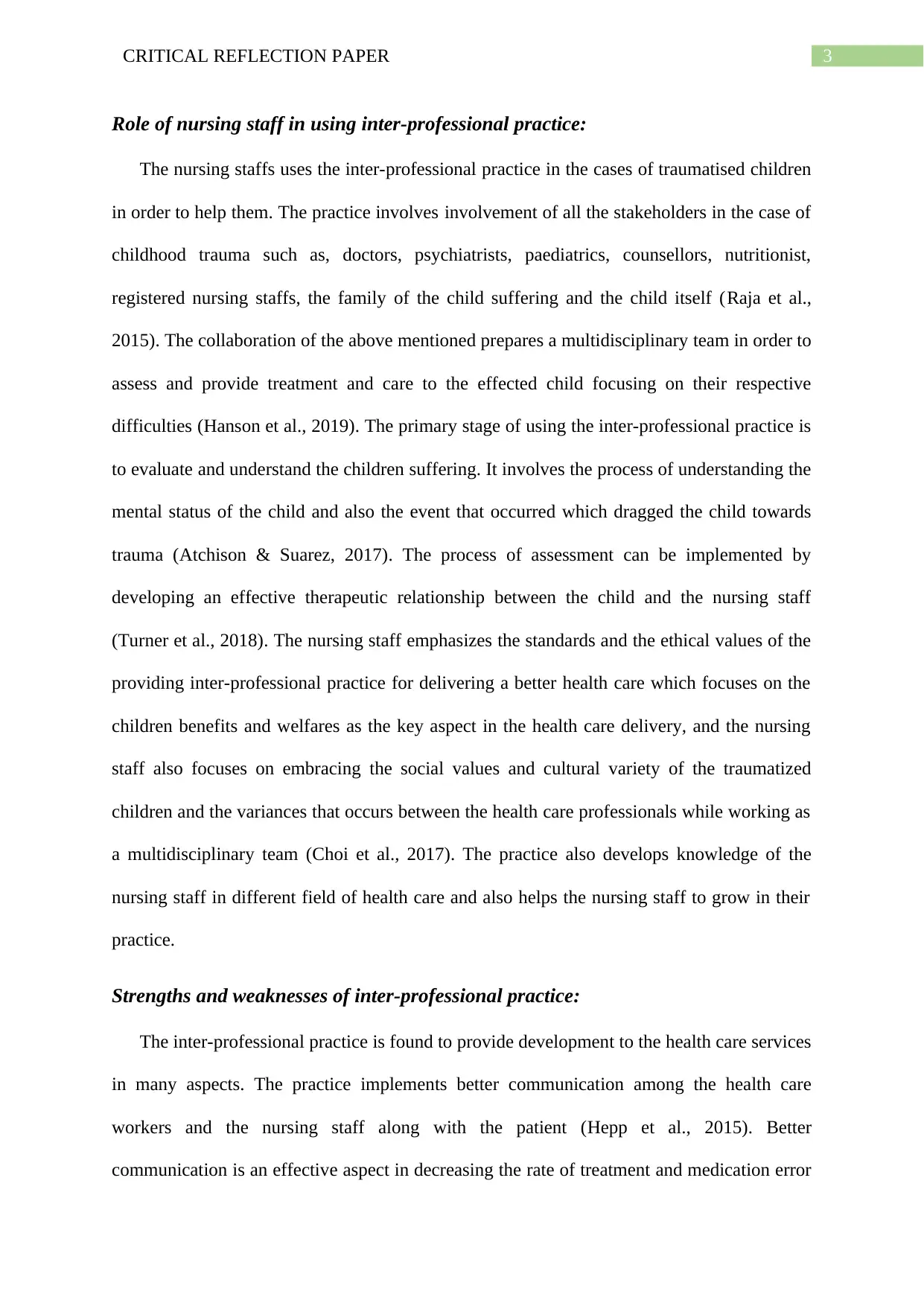
3CRITICAL REFLECTION PAPER
Role of nursing staff in using inter-professional practice:
The nursing staffs uses the inter-professional practice in the cases of traumatised children
in order to help them. The practice involves involvement of all the stakeholders in the case of
childhood trauma such as, doctors, psychiatrists, paediatrics, counsellors, nutritionist,
registered nursing staffs, the family of the child suffering and the child itself (Raja et al.,
2015). The collaboration of the above mentioned prepares a multidisciplinary team in order to
assess and provide treatment and care to the effected child focusing on their respective
difficulties (Hanson et al., 2019). The primary stage of using the inter-professional practice is
to evaluate and understand the children suffering. It involves the process of understanding the
mental status of the child and also the event that occurred which dragged the child towards
trauma (Atchison & Suarez, 2017). The process of assessment can be implemented by
developing an effective therapeutic relationship between the child and the nursing staff
(Turner et al., 2018). The nursing staff emphasizes the standards and the ethical values of the
providing inter-professional practice for delivering a better health care which focuses on the
children benefits and welfares as the key aspect in the health care delivery, and the nursing
staff also focuses on embracing the social values and cultural variety of the traumatized
children and the variances that occurs between the health care professionals while working as
a multidisciplinary team (Choi et al., 2017). The practice also develops knowledge of the
nursing staff in different field of health care and also helps the nursing staff to grow in their
practice.
Strengths and weaknesses of inter-professional practice:
The inter-professional practice is found to provide development to the health care services
in many aspects. The practice implements better communication among the health care
workers and the nursing staff along with the patient (Hepp et al., 2015). Better
communication is an effective aspect in decreasing the rate of treatment and medication error
Role of nursing staff in using inter-professional practice:
The nursing staffs uses the inter-professional practice in the cases of traumatised children
in order to help them. The practice involves involvement of all the stakeholders in the case of
childhood trauma such as, doctors, psychiatrists, paediatrics, counsellors, nutritionist,
registered nursing staffs, the family of the child suffering and the child itself (Raja et al.,
2015). The collaboration of the above mentioned prepares a multidisciplinary team in order to
assess and provide treatment and care to the effected child focusing on their respective
difficulties (Hanson et al., 2019). The primary stage of using the inter-professional practice is
to evaluate and understand the children suffering. It involves the process of understanding the
mental status of the child and also the event that occurred which dragged the child towards
trauma (Atchison & Suarez, 2017). The process of assessment can be implemented by
developing an effective therapeutic relationship between the child and the nursing staff
(Turner et al., 2018). The nursing staff emphasizes the standards and the ethical values of the
providing inter-professional practice for delivering a better health care which focuses on the
children benefits and welfares as the key aspect in the health care delivery, and the nursing
staff also focuses on embracing the social values and cultural variety of the traumatized
children and the variances that occurs between the health care professionals while working as
a multidisciplinary team (Choi et al., 2017). The practice also develops knowledge of the
nursing staff in different field of health care and also helps the nursing staff to grow in their
practice.
Strengths and weaknesses of inter-professional practice:
The inter-professional practice is found to provide development to the health care services
in many aspects. The practice implements better communication among the health care
workers and the nursing staff along with the patient (Hepp et al., 2015). Better
communication is an effective aspect in decreasing the rate of treatment and medication error
Paraphrase This Document
Need a fresh take? Get an instant paraphrase of this document with our AI Paraphraser
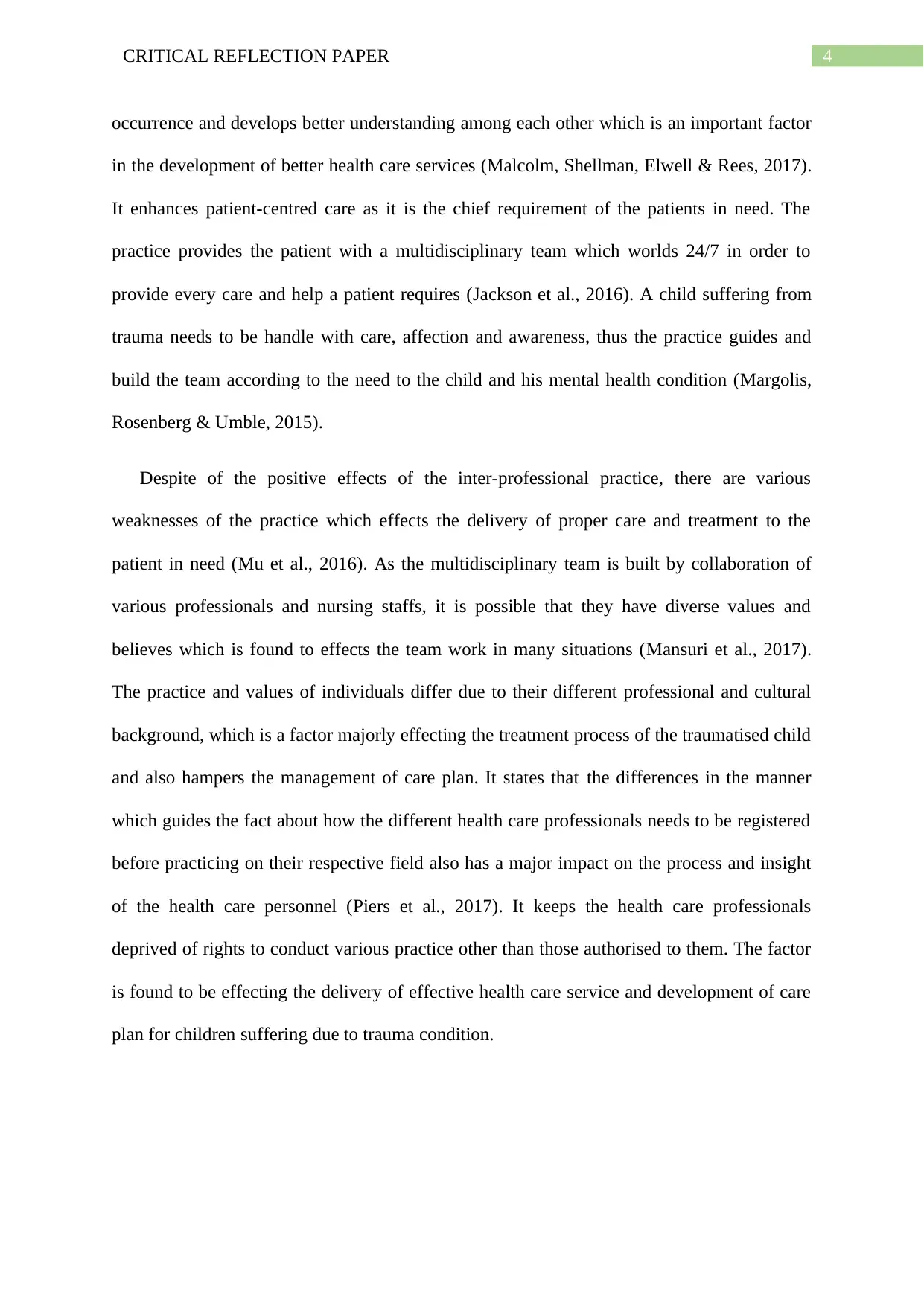
4CRITICAL REFLECTION PAPER
occurrence and develops better understanding among each other which is an important factor
in the development of better health care services (Malcolm, Shellman, Elwell & Rees, 2017).
It enhances patient-centred care as it is the chief requirement of the patients in need. The
practice provides the patient with a multidisciplinary team which worlds 24/7 in order to
provide every care and help a patient requires (Jackson et al., 2016). A child suffering from
trauma needs to be handle with care, affection and awareness, thus the practice guides and
build the team according to the need to the child and his mental health condition (Margolis,
Rosenberg & Umble, 2015).
Despite of the positive effects of the inter-professional practice, there are various
weaknesses of the practice which effects the delivery of proper care and treatment to the
patient in need (Mu et al., 2016). As the multidisciplinary team is built by collaboration of
various professionals and nursing staffs, it is possible that they have diverse values and
believes which is found to effects the team work in many situations (Mansuri et al., 2017).
The practice and values of individuals differ due to their different professional and cultural
background, which is a factor majorly effecting the treatment process of the traumatised child
and also hampers the management of care plan. It states that the differences in the manner
which guides the fact about how the different health care professionals needs to be registered
before practicing on their respective field also has a major impact on the process and insight
of the health care personnel (Piers et al., 2017). It keeps the health care professionals
deprived of rights to conduct various practice other than those authorised to them. The factor
is found to be effecting the delivery of effective health care service and development of care
plan for children suffering due to trauma condition.
occurrence and develops better understanding among each other which is an important factor
in the development of better health care services (Malcolm, Shellman, Elwell & Rees, 2017).
It enhances patient-centred care as it is the chief requirement of the patients in need. The
practice provides the patient with a multidisciplinary team which worlds 24/7 in order to
provide every care and help a patient requires (Jackson et al., 2016). A child suffering from
trauma needs to be handle with care, affection and awareness, thus the practice guides and
build the team according to the need to the child and his mental health condition (Margolis,
Rosenberg & Umble, 2015).
Despite of the positive effects of the inter-professional practice, there are various
weaknesses of the practice which effects the delivery of proper care and treatment to the
patient in need (Mu et al., 2016). As the multidisciplinary team is built by collaboration of
various professionals and nursing staffs, it is possible that they have diverse values and
believes which is found to effects the team work in many situations (Mansuri et al., 2017).
The practice and values of individuals differ due to their different professional and cultural
background, which is a factor majorly effecting the treatment process of the traumatised child
and also hampers the management of care plan. It states that the differences in the manner
which guides the fact about how the different health care professionals needs to be registered
before practicing on their respective field also has a major impact on the process and insight
of the health care personnel (Piers et al., 2017). It keeps the health care professionals
deprived of rights to conduct various practice other than those authorised to them. The factor
is found to be effecting the delivery of effective health care service and development of care
plan for children suffering due to trauma condition.
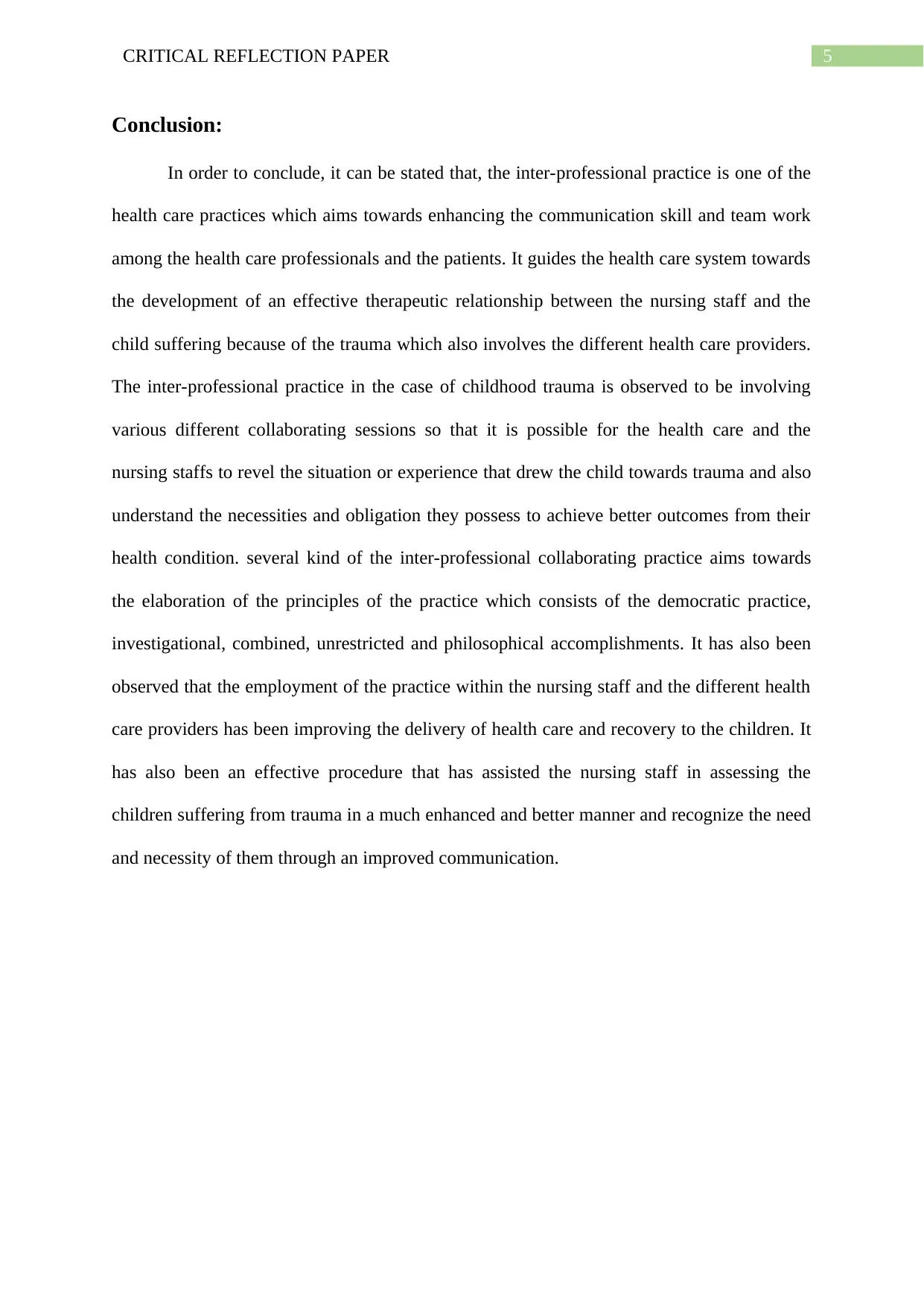
5CRITICAL REFLECTION PAPER
Conclusion:
In order to conclude, it can be stated that, the inter-professional practice is one of the
health care practices which aims towards enhancing the communication skill and team work
among the health care professionals and the patients. It guides the health care system towards
the development of an effective therapeutic relationship between the nursing staff and the
child suffering because of the trauma which also involves the different health care providers.
The inter-professional practice in the case of childhood trauma is observed to be involving
various different collaborating sessions so that it is possible for the health care and the
nursing staffs to revel the situation or experience that drew the child towards trauma and also
understand the necessities and obligation they possess to achieve better outcomes from their
health condition. several kind of the inter-professional collaborating practice aims towards
the elaboration of the principles of the practice which consists of the democratic practice,
investigational, combined, unrestricted and philosophical accomplishments. It has also been
observed that the employment of the practice within the nursing staff and the different health
care providers has been improving the delivery of health care and recovery to the children. It
has also been an effective procedure that has assisted the nursing staff in assessing the
children suffering from trauma in a much enhanced and better manner and recognize the need
and necessity of them through an improved communication.
Conclusion:
In order to conclude, it can be stated that, the inter-professional practice is one of the
health care practices which aims towards enhancing the communication skill and team work
among the health care professionals and the patients. It guides the health care system towards
the development of an effective therapeutic relationship between the nursing staff and the
child suffering because of the trauma which also involves the different health care providers.
The inter-professional practice in the case of childhood trauma is observed to be involving
various different collaborating sessions so that it is possible for the health care and the
nursing staffs to revel the situation or experience that drew the child towards trauma and also
understand the necessities and obligation they possess to achieve better outcomes from their
health condition. several kind of the inter-professional collaborating practice aims towards
the elaboration of the principles of the practice which consists of the democratic practice,
investigational, combined, unrestricted and philosophical accomplishments. It has also been
observed that the employment of the practice within the nursing staff and the different health
care providers has been improving the delivery of health care and recovery to the children. It
has also been an effective procedure that has assisted the nursing staff in assessing the
children suffering from trauma in a much enhanced and better manner and recognize the need
and necessity of them through an improved communication.
⊘ This is a preview!⊘
Do you want full access?
Subscribe today to unlock all pages.

Trusted by 1+ million students worldwide

6CRITICAL REFLECTION PAPER
References:
Atchison, B. J., & Suarez, M. A. (2017). Interprofessional practice and education: multiple
lenses bring a sharper focus. The Open Journal of Occupational Therapy, 5(3), 1.
Bailey, T., Alvarez-Jimenez, M., Garcia-Sanchez, A. M., Hulbert, C., Barlow, E., & Bendall,
S. (2018). Childhood trauma is associated with severity of hallucinations and
delusions in psychotic disorders: a systematic review and meta-analysis.
Schizophrenia bulletin, 44(5), 1111-1122.
Baumeister, D., Akhtar, R., Ciufolini, S., Pariante, C. M., & Mondelli, V. (2016). Childhood
trauma and adulthood inflammation: a meta-analysis of peripheral C-reactive protein,
interleukin-6 and tumour necrosis factor-α. Molecular psychiatry, 21(5), 642.
Choi, K. R., Briggs, E. C., Seng, J. S., Graham-Bermann, S. A., Munro-Kramer, M. L., &
Ford, J. D. (2017). Service usage typologies in a clinical sample of trauma-exposed
adolescents: A latent class analysis.
Domac, S., Anderson, L., O’Reilly, M., & Smith, R. (2015). Assessing interprofessional
competence using a prospective reflective portfolio. Journal of interprofessional care,
29(3), 179-187.
Hanson, R. F., Saunders, B. E., Ralston, E., Moreland, A. D., Peer, S. O., & Fitzgerald, M.
M. (2019). Statewide implementation of child trauma-focused practices using the
community-based learning collaborative model. Psychological services, 16(1), 170.
Hepp, S. L., Suter, E., Jackson, K., Deutschlander, S., Makwarimba, E., Jennings, J., &
Birmingham, L. (2015). Using an interprofessional competency framework to
examine collaborative practice. Journal of interprofessional care, 29(2), 131-137.
References:
Atchison, B. J., & Suarez, M. A. (2017). Interprofessional practice and education: multiple
lenses bring a sharper focus. The Open Journal of Occupational Therapy, 5(3), 1.
Bailey, T., Alvarez-Jimenez, M., Garcia-Sanchez, A. M., Hulbert, C., Barlow, E., & Bendall,
S. (2018). Childhood trauma is associated with severity of hallucinations and
delusions in psychotic disorders: a systematic review and meta-analysis.
Schizophrenia bulletin, 44(5), 1111-1122.
Baumeister, D., Akhtar, R., Ciufolini, S., Pariante, C. M., & Mondelli, V. (2016). Childhood
trauma and adulthood inflammation: a meta-analysis of peripheral C-reactive protein,
interleukin-6 and tumour necrosis factor-α. Molecular psychiatry, 21(5), 642.
Choi, K. R., Briggs, E. C., Seng, J. S., Graham-Bermann, S. A., Munro-Kramer, M. L., &
Ford, J. D. (2017). Service usage typologies in a clinical sample of trauma-exposed
adolescents: A latent class analysis.
Domac, S., Anderson, L., O’Reilly, M., & Smith, R. (2015). Assessing interprofessional
competence using a prospective reflective portfolio. Journal of interprofessional care,
29(3), 179-187.
Hanson, R. F., Saunders, B. E., Ralston, E., Moreland, A. D., Peer, S. O., & Fitzgerald, M.
M. (2019). Statewide implementation of child trauma-focused practices using the
community-based learning collaborative model. Psychological services, 16(1), 170.
Hepp, S. L., Suter, E., Jackson, K., Deutschlander, S., Makwarimba, E., Jennings, J., &
Birmingham, L. (2015). Using an interprofessional competency framework to
examine collaborative practice. Journal of interprofessional care, 29(2), 131-137.
Paraphrase This Document
Need a fresh take? Get an instant paraphrase of this document with our AI Paraphraser
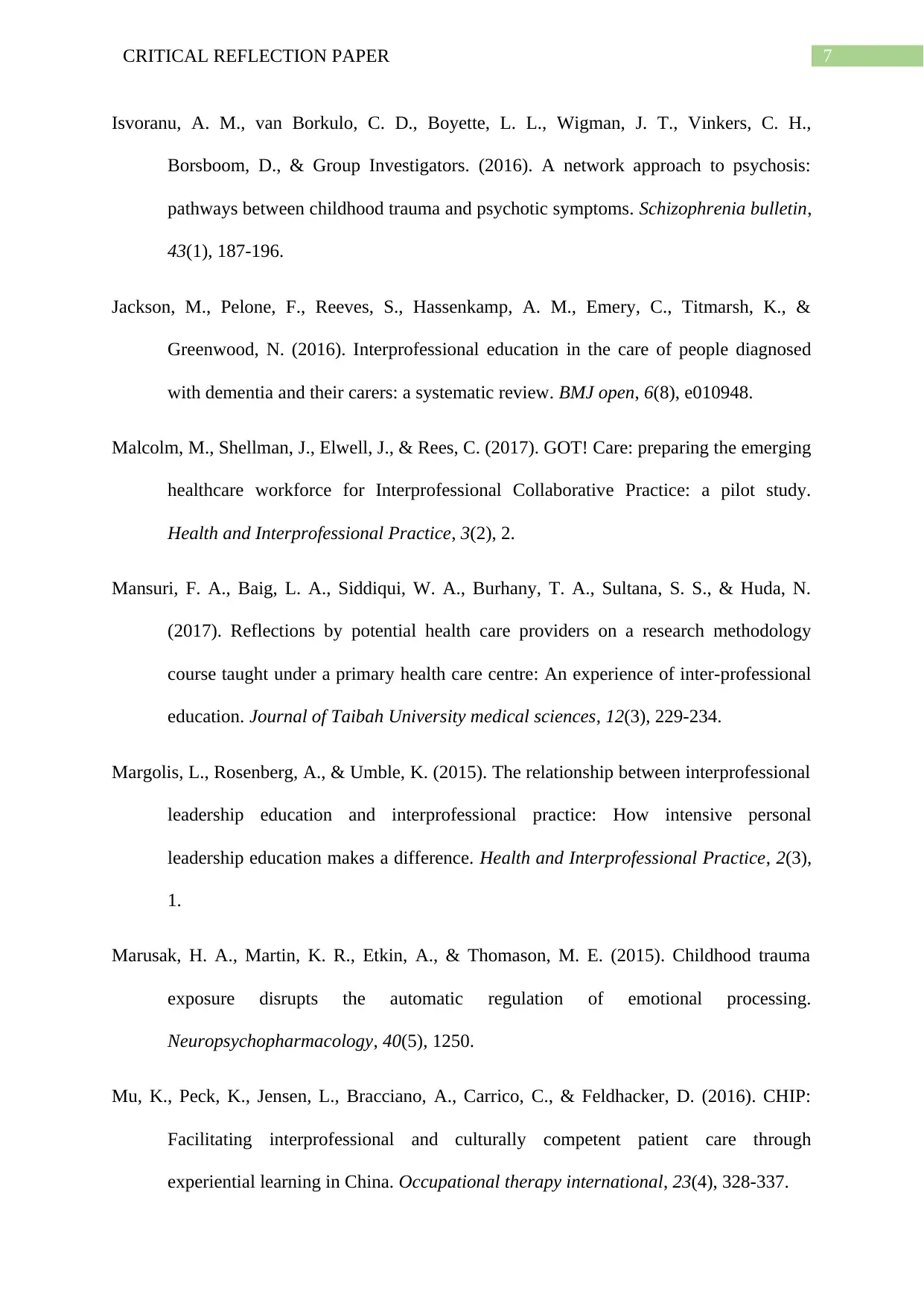
7CRITICAL REFLECTION PAPER
Isvoranu, A. M., van Borkulo, C. D., Boyette, L. L., Wigman, J. T., Vinkers, C. H.,
Borsboom, D., & Group Investigators. (2016). A network approach to psychosis:
pathways between childhood trauma and psychotic symptoms. Schizophrenia bulletin,
43(1), 187-196.
Jackson, M., Pelone, F., Reeves, S., Hassenkamp, A. M., Emery, C., Titmarsh, K., &
Greenwood, N. (2016). Interprofessional education in the care of people diagnosed
with dementia and their carers: a systematic review. BMJ open, 6(8), e010948.
Malcolm, M., Shellman, J., Elwell, J., & Rees, C. (2017). GOT! Care: preparing the emerging
healthcare workforce for Interprofessional Collaborative Practice: a pilot study.
Health and Interprofessional Practice, 3(2), 2.
Mansuri, F. A., Baig, L. A., Siddiqui, W. A., Burhany, T. A., Sultana, S. S., & Huda, N.
(2017). Reflections by potential health care providers on a research methodology
course taught under a primary health care centre: An experience of inter-professional
education. Journal of Taibah University medical sciences, 12(3), 229-234.
Margolis, L., Rosenberg, A., & Umble, K. (2015). The relationship between interprofessional
leadership education and interprofessional practice: How intensive personal
leadership education makes a difference. Health and Interprofessional Practice, 2(3),
1.
Marusak, H. A., Martin, K. R., Etkin, A., & Thomason, M. E. (2015). Childhood trauma
exposure disrupts the automatic regulation of emotional processing.
Neuropsychopharmacology, 40(5), 1250.
Mu, K., Peck, K., Jensen, L., Bracciano, A., Carrico, C., & Feldhacker, D. (2016). CHIP:
Facilitating interprofessional and culturally competent patient care through
experiential learning in China. Occupational therapy international, 23(4), 328-337.
Isvoranu, A. M., van Borkulo, C. D., Boyette, L. L., Wigman, J. T., Vinkers, C. H.,
Borsboom, D., & Group Investigators. (2016). A network approach to psychosis:
pathways between childhood trauma and psychotic symptoms. Schizophrenia bulletin,
43(1), 187-196.
Jackson, M., Pelone, F., Reeves, S., Hassenkamp, A. M., Emery, C., Titmarsh, K., &
Greenwood, N. (2016). Interprofessional education in the care of people diagnosed
with dementia and their carers: a systematic review. BMJ open, 6(8), e010948.
Malcolm, M., Shellman, J., Elwell, J., & Rees, C. (2017). GOT! Care: preparing the emerging
healthcare workforce for Interprofessional Collaborative Practice: a pilot study.
Health and Interprofessional Practice, 3(2), 2.
Mansuri, F. A., Baig, L. A., Siddiqui, W. A., Burhany, T. A., Sultana, S. S., & Huda, N.
(2017). Reflections by potential health care providers on a research methodology
course taught under a primary health care centre: An experience of inter-professional
education. Journal of Taibah University medical sciences, 12(3), 229-234.
Margolis, L., Rosenberg, A., & Umble, K. (2015). The relationship between interprofessional
leadership education and interprofessional practice: How intensive personal
leadership education makes a difference. Health and Interprofessional Practice, 2(3),
1.
Marusak, H. A., Martin, K. R., Etkin, A., & Thomason, M. E. (2015). Childhood trauma
exposure disrupts the automatic regulation of emotional processing.
Neuropsychopharmacology, 40(5), 1250.
Mu, K., Peck, K., Jensen, L., Bracciano, A., Carrico, C., & Feldhacker, D. (2016). CHIP:
Facilitating interprofessional and culturally competent patient care through
experiential learning in China. Occupational therapy international, 23(4), 328-337.
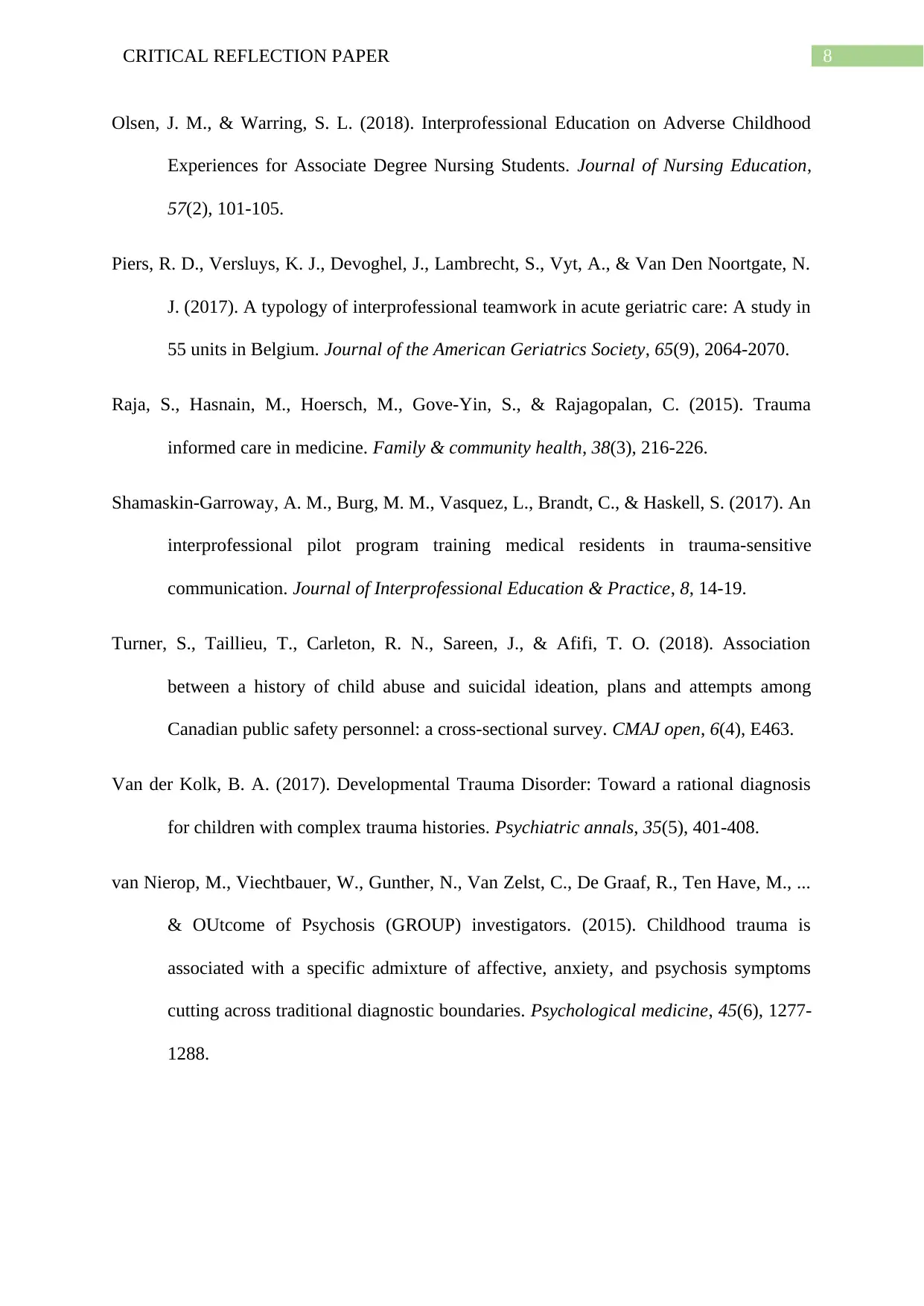
8CRITICAL REFLECTION PAPER
Olsen, J. M., & Warring, S. L. (2018). Interprofessional Education on Adverse Childhood
Experiences for Associate Degree Nursing Students. Journal of Nursing Education,
57(2), 101-105.
Piers, R. D., Versluys, K. J., Devoghel, J., Lambrecht, S., Vyt, A., & Van Den Noortgate, N.
J. (2017). A typology of interprofessional teamwork in acute geriatric care: A study in
55 units in Belgium. Journal of the American Geriatrics Society, 65(9), 2064-2070.
Raja, S., Hasnain, M., Hoersch, M., Gove-Yin, S., & Rajagopalan, C. (2015). Trauma
informed care in medicine. Family & community health, 38(3), 216-226.
Shamaskin-Garroway, A. M., Burg, M. M., Vasquez, L., Brandt, C., & Haskell, S. (2017). An
interprofessional pilot program training medical residents in trauma-sensitive
communication. Journal of Interprofessional Education & Practice, 8, 14-19.
Turner, S., Taillieu, T., Carleton, R. N., Sareen, J., & Afifi, T. O. (2018). Association
between a history of child abuse and suicidal ideation, plans and attempts among
Canadian public safety personnel: a cross-sectional survey. CMAJ open, 6(4), E463.
Van der Kolk, B. A. (2017). Developmental Trauma Disorder: Toward a rational diagnosis
for children with complex trauma histories. Psychiatric annals, 35(5), 401-408.
van Nierop, M., Viechtbauer, W., Gunther, N., Van Zelst, C., De Graaf, R., Ten Have, M., ...
& OUtcome of Psychosis (GROUP) investigators. (2015). Childhood trauma is
associated with a specific admixture of affective, anxiety, and psychosis symptoms
cutting across traditional diagnostic boundaries. Psychological medicine, 45(6), 1277-
1288.
Olsen, J. M., & Warring, S. L. (2018). Interprofessional Education on Adverse Childhood
Experiences for Associate Degree Nursing Students. Journal of Nursing Education,
57(2), 101-105.
Piers, R. D., Versluys, K. J., Devoghel, J., Lambrecht, S., Vyt, A., & Van Den Noortgate, N.
J. (2017). A typology of interprofessional teamwork in acute geriatric care: A study in
55 units in Belgium. Journal of the American Geriatrics Society, 65(9), 2064-2070.
Raja, S., Hasnain, M., Hoersch, M., Gove-Yin, S., & Rajagopalan, C. (2015). Trauma
informed care in medicine. Family & community health, 38(3), 216-226.
Shamaskin-Garroway, A. M., Burg, M. M., Vasquez, L., Brandt, C., & Haskell, S. (2017). An
interprofessional pilot program training medical residents in trauma-sensitive
communication. Journal of Interprofessional Education & Practice, 8, 14-19.
Turner, S., Taillieu, T., Carleton, R. N., Sareen, J., & Afifi, T. O. (2018). Association
between a history of child abuse and suicidal ideation, plans and attempts among
Canadian public safety personnel: a cross-sectional survey. CMAJ open, 6(4), E463.
Van der Kolk, B. A. (2017). Developmental Trauma Disorder: Toward a rational diagnosis
for children with complex trauma histories. Psychiatric annals, 35(5), 401-408.
van Nierop, M., Viechtbauer, W., Gunther, N., Van Zelst, C., De Graaf, R., Ten Have, M., ...
& OUtcome of Psychosis (GROUP) investigators. (2015). Childhood trauma is
associated with a specific admixture of affective, anxiety, and psychosis symptoms
cutting across traditional diagnostic boundaries. Psychological medicine, 45(6), 1277-
1288.
⊘ This is a preview!⊘
Do you want full access?
Subscribe today to unlock all pages.

Trusted by 1+ million students worldwide
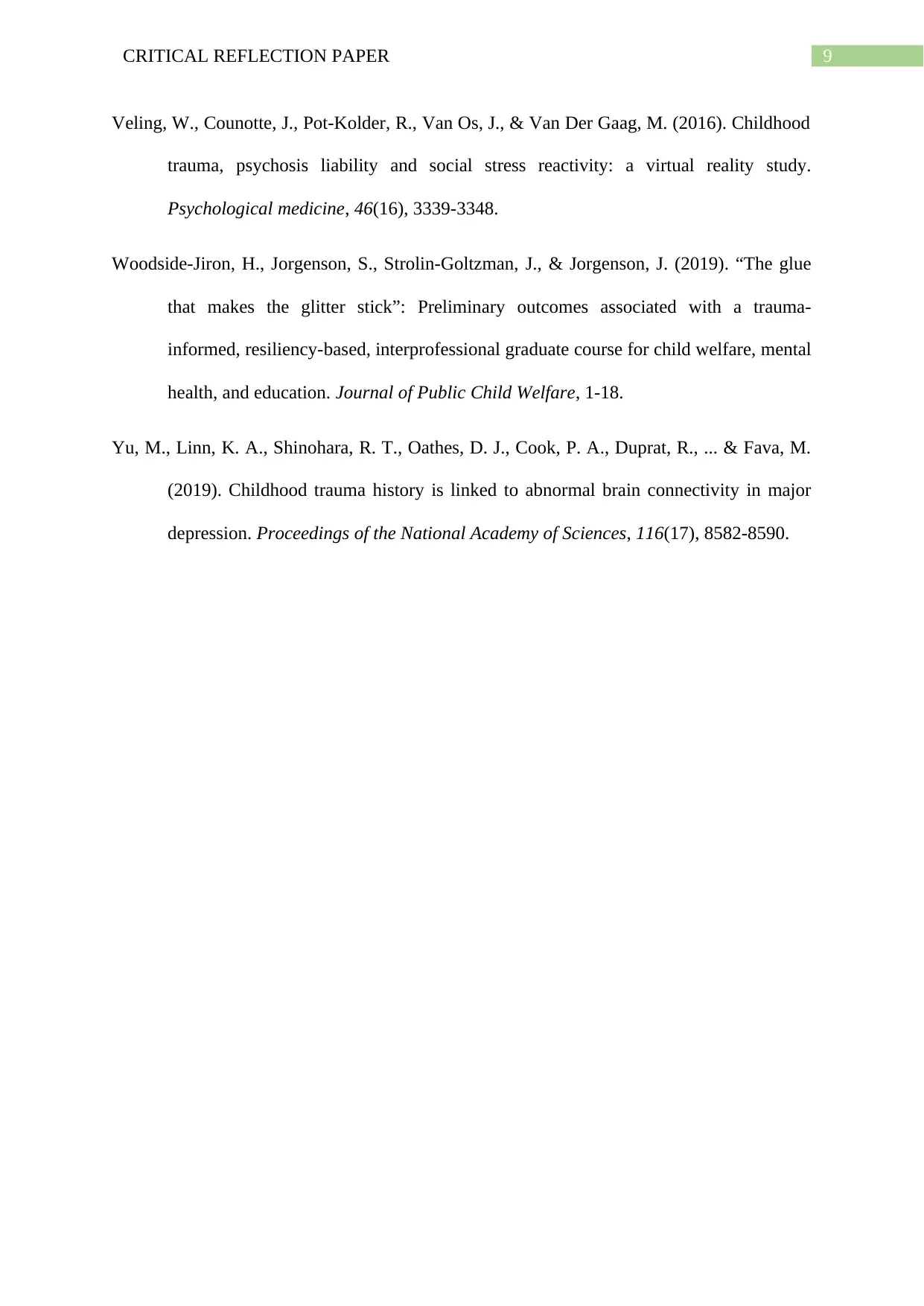
9CRITICAL REFLECTION PAPER
Veling, W., Counotte, J., Pot-Kolder, R., Van Os, J., & Van Der Gaag, M. (2016). Childhood
trauma, psychosis liability and social stress reactivity: a virtual reality study.
Psychological medicine, 46(16), 3339-3348.
Woodside-Jiron, H., Jorgenson, S., Strolin-Goltzman, J., & Jorgenson, J. (2019). “The glue
that makes the glitter stick”: Preliminary outcomes associated with a trauma-
informed, resiliency-based, interprofessional graduate course for child welfare, mental
health, and education. Journal of Public Child Welfare, 1-18.
Yu, M., Linn, K. A., Shinohara, R. T., Oathes, D. J., Cook, P. A., Duprat, R., ... & Fava, M.
(2019). Childhood trauma history is linked to abnormal brain connectivity in major
depression. Proceedings of the National Academy of Sciences, 116(17), 8582-8590.
Veling, W., Counotte, J., Pot-Kolder, R., Van Os, J., & Van Der Gaag, M. (2016). Childhood
trauma, psychosis liability and social stress reactivity: a virtual reality study.
Psychological medicine, 46(16), 3339-3348.
Woodside-Jiron, H., Jorgenson, S., Strolin-Goltzman, J., & Jorgenson, J. (2019). “The glue
that makes the glitter stick”: Preliminary outcomes associated with a trauma-
informed, resiliency-based, interprofessional graduate course for child welfare, mental
health, and education. Journal of Public Child Welfare, 1-18.
Yu, M., Linn, K. A., Shinohara, R. T., Oathes, D. J., Cook, P. A., Duprat, R., ... & Fava, M.
(2019). Childhood trauma history is linked to abnormal brain connectivity in major
depression. Proceedings of the National Academy of Sciences, 116(17), 8582-8590.
1 out of 10
Related Documents
Your All-in-One AI-Powered Toolkit for Academic Success.
+13062052269
info@desklib.com
Available 24*7 on WhatsApp / Email
![[object Object]](/_next/static/media/star-bottom.7253800d.svg)
Unlock your academic potential
Copyright © 2020–2025 A2Z Services. All Rights Reserved. Developed and managed by ZUCOL.




